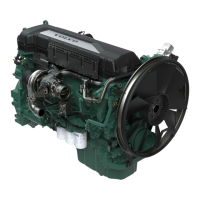
Do you have a question about the Volvo Penta TAD1344GE and is the answer not in the manual?
| Engine Model | TAD1344GE |
|---|---|
| Engine Speed | 1500 rpm |
| Number of Cylinders | 6 |
| Bore | 131 mm |
| Stroke | 158 mm |
| Fuel System | Common rail |
| Cooling System | Water-cooled |
Introduces Volvo Penta engines and the Operator's Manual, emphasizing safety and maintenance.
Covers safety text priority, symbols, and general precautions for engine operation and maintenance.
Discusses appropriate safety gear and its importance for injury reduction during operation.
Covers eye and skin protection, fire prevention measures, and explosion risks.
Safety rules for spare parts, used materials, engine start, and ventilation requirements.
Warnings about rotating parts, hot surfaces, and the prohibition of start spray.
Safety procedures before working on electrical, welding, and cooling systems.
Safety for hot fluids, refueling, fuel quality, and legal requirements.
Safety for fuel leaks, pipes, batteries, electrolyte risks, and polarity.
Safety procedures for cleaning engine components and adjusting the clutch.
Describes the Operator's Manual content and outlines warranty responsibilities.
Details the engine running-in process and recommendations for fuel, oils, and coolant.
Highlights the importance of maintenance, genuine parts, and environmental considerations.
Specifies requirements for emission-certified engines to maintain conformity.
Information on the dealer network and Volvo Penta Action Service for support.
Overview of the engine models covered by this Operator's Manual.
Description of the electronic engine management system (EMS) and its functions.
Introduction to the DCU instrument panel and its capabilities.
How to start the engine and navigate the DCU menus.
Details on main menu options and the display of engine data.
Explains preheat, governor mode, and diagnostics functions.
Covers setup, customer parameters, and throttle settings.
Details display settings and system information.
Introduction to the DCU II instrument panel.
Explains DCU II display, status bar, and alarm messages.
Description and display modes of the DU.
Displays related to engine status and trip computer.
Covers configuration menu, units, and alarm status.
Description of the CIU and its role as a translator.
List of available Easy Link instruments for monitoring.
Pre-start checks for oil, fuel, coolant, and general engine condition.
Steps for starting the engine with or without pre-heating using the DCU.
Preparations and considerations for starting the engine in very cold conditions.
Warnings against start spray and procedures for using auxiliary batteries.
Checking instruments after starting and understanding alarm signals.
Guidance on maneuvering and the risks associated with low load operation.
Procedure for preparing the engine for shutdown, including warm-up.
Step-by-step instructions to stop the engine using the control panel.
Actions to take after the engine has stopped, including leak checks and long stoppages.
Purpose and operation of the diagnostic function for monitoring and protection.
Table of symptoms and their possible causes for engine malfunctions.
Reference for fault codes, including SPN, PID, FMI, and flash codes.
Overview of regular and extended service intervals for engine maintenance.
Visual checks of the engine and compartment before and after operation.
Checking and replacing the cooling air filter.
Inspecting charge air pipes and hoses for leaks and damage.
Inspecting and replacing drive belts and alternator belts.
Information on oil change intervals, oil pressure, and oil recommendations.
Procedures for checking engine oil level and changing engine oil.
Procedure for cleaning and replacing oil and by-pass filters.
Covers fuel system checks, condensate draining, and filter replacement.
Procedure for replacing the engine fuel filter.
Procedure for changing the fuel pre-filter and water trap.
Procedure for bleeding air from the fuel system.
Information about the cooling system and coolant mixing.
Procedure for checking and topping up the coolant level.
Procedure for filling a completely empty cooling system.
Procedures for draining coolant and cleaning the charge air cooler.
Procedure for cleaning the cooling system.
Installation and cleaning of the cooling air filter.
Information on the electrical system, main switch, and fuses.
Procedures for battery maintenance and replacement.
Guidelines for storing the engine to prevent damage during long periods.
Procedures for taking the engine out of storage and preparing it for use.
Technical details for various engine models, including bore, stroke, and weight.
Oil change volumes, oil pressure, and oil recommendations.
Guidelines for selecting engine oil viscosity based on temperature.
Fuel system parameters, general requirements, and restrictions for fuels.
Cooling system capacities, pressure, and thermostat opening temperature.
Guidelines for coolant mixing and water quality standards.
Electrical system voltage, alternator specifications, and platform details.
Location and explanation of engine identification labels.











